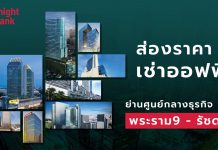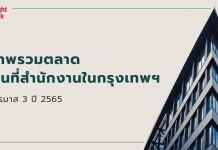Mr. Marcus Burtenshaw, Executive Director, Head of Occupier Services & Commercial Agency, Knight Frank Thailand said that “The first half of 2019 has seen office rents soar to never before seen levels, and whilst occupancy rates remain high, the influx of new supply over the next six months coupled with economic headwinds will be a real test for the market, however tenants whose leases are expiring will still be faced with the problem of rising accommodation costs for the foreseeable future.”

Economic Overview
Political uncertainty coupled with the US – China trade war has had a dampening effect on the Thai economy. As a result, the World Bank projects that economic growth will fall to 3.5% this year from 4.1% in the previous year. Exports have also contracted by 4% in Q1 2019 – the first quarterly decline in three years as the baht continues to appreciate against the US dollar. Meanwhile, public investments in infrastructure, which have been identified as a major growth driver for the economy, have slowed in implementation due to election-related delays. Nevertheless, low inflation, rising employment levels, and rising recurrent fiscal spending are still boosting private investment and household consumption to grow close to their three-year high.
Supply
According to Knight Frank Thailand Research, In Q2, one new office building was completed outside the CBD. As a result,
Figure 1
Bangkok Office Quarterly Take Up

Future Supply
The office market is projected to receive an influx of new supply in the remaining half of the year. Five projects are expected to be completed in Q3 and Q4, adding 153,187 square metres of new office space. This is over three times the amount of new supply that entered in the first half of the year. The additions will mainly be located in
non-CBD regions. Two buildings will add 62,000 square metres of office space to the CBD, while the other three new buildings will add 91,187 square metres to non-CBD areas.
Table 1
Bangkok Office Future Supply

From H2 2019 to 2023, the Bangkok office market is expected to grow by 1,170,638 square metres or an average of 234,128 square metres annually. This represents a supply growth rate of approximately 4.3% per year. In comparison, from 2014 to 2018, supply grew by 129,888 square metres or 2.6% annually. By the end of 2023, the total market supply will reach 6.2 million square metres.
Figure 2
Bangkok Office Future Supply (2019-2023)

Table 2
Bangkok Office Future Supply (Projects)

Demand
Net absorption was positive at 5,910 square metres in this quarter, increasing total occupied space to 4,575,121 square metres. Despite the quarterly increase, total occupied space is still down Y-o-Y. Over the past 12 months, total supply increased by 30,190 square metres but total occupied space declined by 22,794 square metres over the same period. This suggests that annual demand was lower than supply. Given the economic slowdown and lack of prime properties added to the CBD in the past year, current and potential tenants could be adopting a ‘wait and see’ approach on any office relocation or expansion plans that they may have.
Figure 3
Bangkok Office Supply – Demand Dynamics

Overall market occupancy rate dropped to 91.0% from 91.7% in Q2 2019. Despite the slight decline, the market occupancy rate has remained relatively consistent. The rate has been within a healthy range of 91% to 93% over the past five years,
Figure 4
Bangkok Office Supply, Demand and Occupancy Rate

Occupancy rates fell across all office grades. The average occupancy rate for grade A office buildings is 94.5%, having declined by 1.3% Q-o-Q. The grade B occupancy rate also fell slightly to 92.1% from 92.4%. Despite the decline, average occupancy rates for both grades are still above their 10-year averages at 91.0%. Grade C office space remains the weakest sector as the occupancy rate fell to 87.1%, below its 10-year average.
Table 3
Bangkok Office Occupancy Rate by Grade

Rental Rates
Average asking rent remained constant at 781 baht per square metre per month. Despite no growth Q-o-Q, rents are still up 4.3% Y-o-Y. This breaks the trend of consecutive rental increases since Q4 2012. In prior quarters, rents increased by approximately 4.7% annually. Grade A rents declined to 1,142 baht per square metre per month from 1,144 baht, but are 9.2% higher Y-o-Y. Meanwhile, grade B and grade C buildings experienced little to no rent growth, having slightly increased to 815 baht and remaining at 496 baht, respectively. Many landlords responded to the marginal occupancy drop and weakened economic conditions by keeping asking rents constant or lower from the previous quarter.
Figure 5
Bangkok Office Average Asking Rent by Grade

Sub-Market Rents
In the CBD, the Ploenchit – Chidlom area experienced the highest rental growth, increasing by 2% to 958 baht per square metre per month. Despite no overall increases this quarter, office spaces on Wireless Road still command the highest rents at 1,101 baht, representing a 6.3% increase Y-o-Y. Outside of the CBD, rents grew in all sub-markets sampled except for Paholyothin – Viphavadi, which experienced a 0.3% Q-o-Q drop in rents to 723 baht. Interestingly, across all sub-markets sampled with the exception of Wireless Road, rents moved in opposition to the occupancy rate. Areas with rental escalations experienced occupancy drops with the opposite occurring when asking rent fell.
Table 4
Bangkok Office Sub-Market Indicators

Outlook
We maintain the expectation that demand will pick up throughout the rest of the year as a result of greater post-election political stability, albeit at a subdued level due to the current economic uncertainty and cautious outlook. The office market response to the supply entering in Q3 and Q4 will be a key indicator of demand over the next few years. Given projections that supply will increase by 4.3% annually from 2019 to 2023, occupancy rates will drop if demand lags behind supply. If asking rents rise, it may occur at a slower pace as tenant bargaining power grows with increasing options of high quality office space.



















